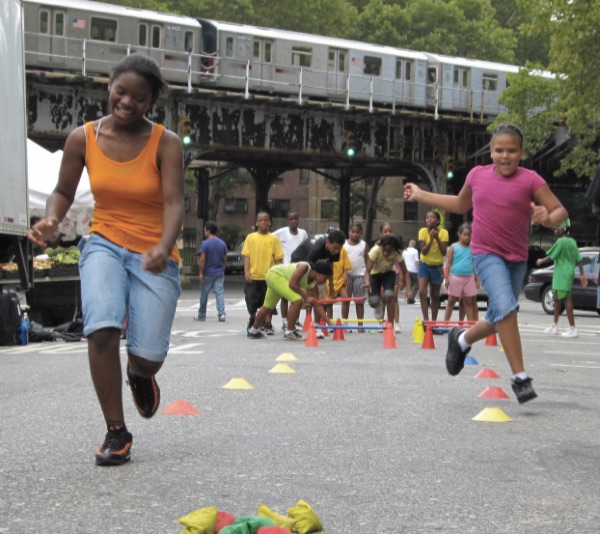As Jim Dwyer reported recently in the Times, NYC’s Play Streets program is on the decline, with just 15 locations on this summer's schedule -- representing a 90 percent drop from the program at its height.
One factor could be that community groups looking to host Play Streets must go through an onerous application process with multiple veto points.
The city's first official play streets date to 1914, and according to the Times were started by Police Commissioner Arthur Woods “to keep young people out of trouble.” But that’s only part of the story.
“The motives for play streets included keeping kids out of trouble AND out of deadly traffic from the start,” said Peter Norton, author of “Fighting Traffic,” in an email to Streetsblog.
In a story published in the spring of 1916, the Times reported that Woods wanted to close 100 streets to motor vehicle traffic to provide kids with safe outdoor spaces [PDF]. “The children have simply got to be taken care of,” Woods said. “We can’t dodge the responsibility, and the sooner we get them off the streets and out from under the wheels of vehicles just so soon will the street accidents begin to go down and not until then.”
According to the Times, in 1915 there were “only fifteen such play streets” -- the same number as in 2017, down from a peak of around 150 in the late 1990s to early 2000s.
Historically, most Play Streets were administered by the Police Athletic League. At one time the Housing Authority also funded scores of locations, before budget problems led to cutbacks. Dwyer reported that city funding for PAL-hosted Play Streets was halved this year compared to 2016, as resources are shifted from less structured play on neighborhood blocks to “more curated experiences,” like sports and other organized activities on city courts and playgrounds.
But not all kids live near recreation facilities. Says the Trust for Public Land:
Thousands of New York City children do not have access to a close to home park or playground. In fact, 73 percent of the city’s low-income neighborhoods fail to meet the city’s standard of 2.5 acres of parkland per 1,000 residents. In these communities, many of the schools have no playground facilities at all. This scarcity of outdoor play opportunities contributes to high rates of childhood obesity, diabetes, asthma, and other health problems.
And as one Hamilton Heights resident told Jim Dwyer, “Nothing like your own block.”
This year, all of the city's Play Streets are PAL-affiliated. Meanwhile, an initiative that lets community and neighborhood organizations host their own Play Streets by applying through the Health Department and DOT has no active locations.
Obstacles abound for local groups that want their own Play Streets. For instance, the city won't approve Play Streets without the blessing of the local police precinct and the local community board -- which is apt to be more concerned with keeping drivers happy than giving kids room to play.
Money might also pose a problem. A few years back, the mayor's Street Activity Permit Office proposed a mandatory million-dollar liability policy for Play Streets events, which could make them cost-prohibitive for volunteer community groups.
It’s unclear if the insurance requirement is in effect. Streetsblog called SAPO Play Streets coordinator Maureen DeSantis to ask, but DeSantis declined to speak with us about the program. A message with another SAPO employee had not been returned as of this writing.
Streetsblog asked DOT and DOH for data on Play Streets that are not operated by PAL. Both agencies referred us to City Hall, which sent a statement that referred to the reduction in PAL events:
City Hall was not made aware of these closures and we can understand why some are upset. We are reviewing this decision further to ensure it meets our goal of providing engaging and convenient recreational programming for all our city's kids.
In 2011, Transportation Alternatives published a primer on the history of Play Streets, the benefits to children and neighborhoods, and tips on how to win application approval.
"There's not an easy online portal that facilitates the application process," says TransAlt Director of Organizing Tom DeVito, "whether it's Play Streets, bike rack requests, or Street Seats."
DeVito points out that the city does not publish data on how many Play Streets applications are submitted, or the number of permits granted, so the public doesn't know how efficient the city is in processing approvals.
In August, says DeVito, TransAlt will launch an online "one-stop shop" where people can file applications for Play Streets and about a dozen other city programs.





